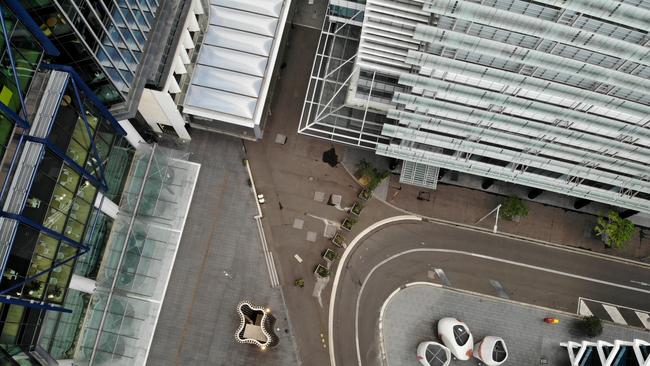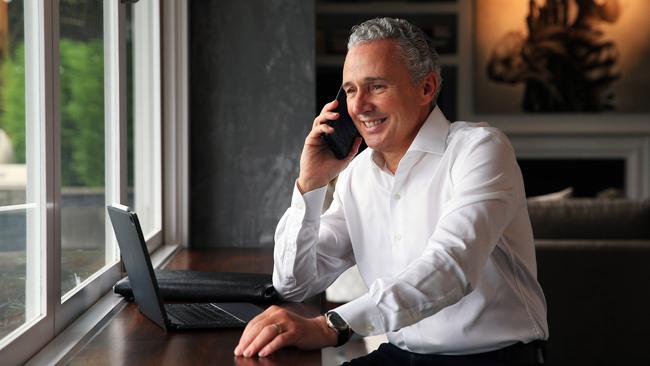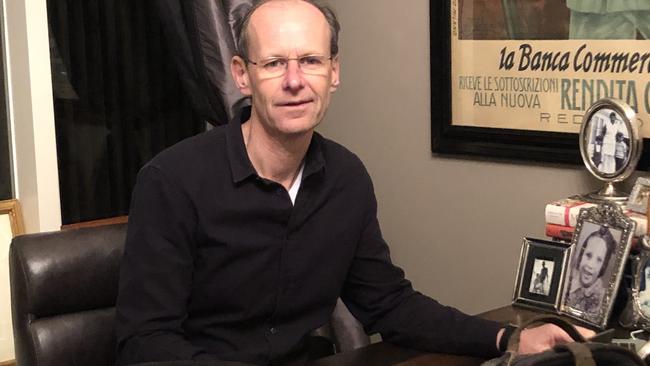The mad scramble that changed the workplace forever
Only two days after the WHO ended its strange reluctance to declare COVID-19 a pandemic, Telstra’s Andy Penn unveiled a plan to resolve the creeping anxiety in his workforce. He sent everyone home. All 20,000 of them.

A year ago today, only two days after the World Health Organisation ended its strange reluctance to declare COVID-19 a pandemic, Telstra chief executive Andy Penn unveiled a plan to resolve the creeping anxiety in his workforce.
He sent everyone home. All 20,000 of them. No longer would they congregate in large numbers, shake hands and unknowingly lower their guards against a deadly disease.
Other firms had preceded Telstra, but not at the scale of Penn’s grand plan. It was the start of a COVID-19-inspired workplace revolution.
As Penn prepared his work-from-home announcement, ANZ’s global network in Asia, including China, had alerted chief executive Shayne Elliott’s to the virus’s likely course.

In late February, as part of a whistlestop tour through the Pacific region, Elliott was about to leave the Solomon Islands when he heard a “mystery virus” had infected some ANZ staff in Fiji — his next destination.
He assessed the risk and diverted to Melbourne, only to later hear it was a false alarm. The diversion was useful, however, because it rapidly became clear that extreme measures were needed to protect the health of the bank’s 50,000-strong global workforce.
While ANZ’s investment in a more agile workforce meant that most of the infrastructure was in place for a transition to working from home, no one had anticipated that everyone would move at once.
A mad two-week scramble for bandwidth ensued, continuing through the weekend of March 14-15, before ANZ confirmed on Sunday night that non-essential staff who wanted to work at home from Monday could do so.
“There’s never been anything as massive as that in terms of workplace change in my entire career,” Elliott tells The Weekend Australian.
“We have a global business and because of our business continuity planning we experience this kind of challenge regularly with floods, cyclones or bushfires, but they tend to impact a small group of branches or in some cases a city.
“We’ve never had to deal with 30 countries all at once. It was the sheer scale of it.”
On the eve of the biggest change in the bank’s workplace, probably since the bank’s inception, Elliott sent an email to all staff.
The tone was sober but realistic.
It started by noting that COVID-19 was now spreading around the world and was “becoming very real for us in Australia”.
“While the number of confirmed cases in Australia is low compared to places like Europe and Asia, we’ve all witnessed extraordinary events including the federal government banning all large gatherings of over 500 people and widespread shortages of essential items in our supermarkets, causing emotional responses in the community,” the email says.
“This understandably makes many of us anxious about how the virus may impact our families, friends and colleagues.
“Exposure to conflicting and confusing information from multiple sources has also made it hard for us to know what information to trust and what action to take.”
Until then, Australia’s remoteness had fed its usual complacency, with only a dozen COVID-19 infections reported at the start of February — all of them linked by travel to ground zero in Wuhan, China. However, the Department of Health had warned that the nature of transmission was poorly understood.

The early innocence was exemplified on February 20, when the S&P/ASX200 index cruised effortlessly to a record high of 7162.5 points, but it was the calm before the storm.
The main trigger was a COVID-19 surge in pockets of South Korea, Italy and Iran — not enough to convince the WHO to ring its pandemic bell, but more than enough for pandemonium to break out on global markets.
In the last five trading days of the month, $210bn, or 10 per cent, was stripped from the value of local equities in the bourse’s worst week since the GFC.
The dollar tumbled to its lowest level in 11 years. But it was only the beginning.
In the following two weeks, dramatic economic events unfolded.
The Reserve Bank became the only central bank apart from the People’s Bank of China to slash interest rates in response to the pandemic, and the major banks joined Team Australia to pass on the 25 basis-point rate cut in full.
Scott Morrison also delivered on expectations, unveiling the first of what became several stimulus packages, while the RBA momentously discarded its opposition to quantitative easing.
The daily routine of emergency measures, and the dawning reality that very little was actually known about the virus’s qualities, was fanning the level of anxiety.
Elliott could have worked from home himself — hilariously, he was grouped with non-essential ANZ staff because all he needed to do his job was a smartphone — but chose not to.
“People naturally expect their leaders to set an example in a crisis, so in the beginning it was important for me to show I wasn’t scared to come into the office — we still had so many people working at contact centres to take calls and deal with hardship cases,” he says. “Nobody really knew how the virus was transmitted.
“I couldn’t expect people to come into the office if I wasn’t prepared to do the same myself, so I came in every day for the first six months and made it very clear where I was.”
Initially, Elliott hosted a daily half-hour call open to all staff, as part of a plan to “radically” lift staff and customer engagement.
It was important to change his management style, he believes, because people tend to search for clarity and direction in a crisis.
Customers would also join in the calls, almost like a radio spot.
The chef Shane Delia talked about the massive changes brought about by COVID-19 in the restaurant industry, while the chief executive of the national supermarket chain Ritchies, Fred Harrison, told of booming sales and toilet paper shortages.
As the initial panic subsided, so did the need for daily calls.
They became a weekly event, and then fortnightly as staff became more confident about the health risks and the discussion turned to vaccines.
Last July, Elliott started working from home.
As the year progressed, the sheer scale of the fiscal and monetary stimulus began to bite and the economy started to spring to life, with the strength of the recovery leaving mouths agape.
Elliott’s counterparts offshore continually express shock that people in Australia can go to restaurants and even the football.
But the subject which truly exercises their minds is the future of the workplace. “The discussion is all about the future of the office and what it means — not just how much real estate you’re going to give up but how you maintain a culture when you’re hiring people remotely,” Elliott says.
“What are the implications of that, and what does it mean for leaders and managers who have learnt to manage people by sitting down with them and seeing them?
“Irrespective of where you work, everyone recognises that there’s been a pivot point where work is not going to be the same, but it’s all a question of degree.
“And there’s a huge range of views about what that degree is.”



To join the conversation, please log in. Don't have an account? Register
Join the conversation, you are commenting as Logout